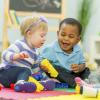- Identify ways the environment can promote social-emotional development in infants and toddlers.
- Explore how routines, materials, and individualized care can provide support and prevent challenging behaviors
- Learn how to encourage families to consider the home environment as an opportunity to promote social-emotional development of their infants and toddlers.
Learn
Know
Research highlights that the quality of a caregiving environment has a significant impact on a young child’s future. Creating an environment that promotes relationship building and fosters healthy social interactions takes intentionality and planning. When preparing your early care and learning environment, it is important to think about caregiving routines and ways to families’ backgrounds and traditions. Your goal is to create an environment that supports the social-emotional development of all infants, toddlers, and families. This is especially important for those infants and toddlers who are particularly vulnerable because of stress, poverty, or other adverse early experiences. This lesson will explore how high-quality environments support the social-emotional development of all infants and toddlers in your care.
We know that many factors influence child development. While some, such as genetics, are out of our control, environmental factors are very much within our control. Developmental psychologist, Urie Bronfenbrenner, studied the impact of the social environment on human development. Bronfenbrenner’s ecological systems theory explains how the environment you grow up in affects your thinking, emotions, and interests. His theory considers five interrelated systems and their impact on children. These systems include:
- Microsystem: The microsystem is made up of groups that have direct contact with the child including family and school or child care.
- Mesosystem: The mesosystem is made up of the relationships between the groups from the first system. An example could be the parent-teacher relationship, and how it affects the child.
- Exosystem: The exosystem includes factors that affect the child’s life, but do not have direct connection with the child. An example of this could be their parents’ workplace.
- Macrosystem: The macrosystem contains cultural elements such as family values and religion.
- Chronosystem: The chronosystem refers to the stage of life that the person or child is in and how it affects various situations. This includes the changes in a person or environment over time.
While this systems theory does not account for biological factors, it does help us to think about the ways in which the environment and relationships impact children’s development and behavior. It encourages the caregiver to consider the whole child when planning the environment and space in which they will learn and grow.
Creating Environments That Support Children’s Social-Emotional Development
Consider the following characteristics of high quality, supportive environments when it comes to young children’s social-emotional development and learning:
Nurturing relationships
The quality and reliability of nurturing and responsive relationships within the early care and learning environment are critical for healthy social-emotional development and learning. Research highlights that overall healthy development (physical, cognitive, emotional, social, and behavioral) depends on the quality and reliability of young children’s relationships with parents and caregivers. Caregivers can:
- Create environments that welcome and encourage family engagement
- Observe and pay close attention to infants and toddlers to promote peer connections in the environment and reduce conflicts
- Interact with infants and toddlers to match their temperament style, provide predictable and consistent experiences, facilitate verbal and nonverbal communication, and encourage safe exploration and problem solving
- Support family engagement by acknowledging the strengths of families, encouraging communication, and focusing on the infant, toddler, and family while showing appreciation for their unique background and experiences
Early Brain Development
Environments make a difference in brain development. Environments that provide consistent, warm and nurturing care, proper nutrition, periods of sleep, and physical activity help prepare the brain to function and develop optimally. Caregivers can:
- Provide and support regularly scheduled sleeping and resting routines, as well as movement and physical activities
- Respond promptly to the needs of infants and toddlers.
- Share information about ways to support early brain development with families.
- Learn about community resources. Developmental screenings can help identify and understand possible early sensory deficits that can interfere with the brain’s natural response to experiences.
Caregivers can also interact with infants and toddlers by engaging in the “serve and return” process. This occurs when young children seek interaction through such things as babbling and facial expressions—the serve—and adults respond, share, and support the infant’s or toddler’s experience or focus of attention—the return. To learn more about “serve and return,” access the video clip from the Center on the Developing Child: http://developingchild.harvard.edu/resources/multimedia/videos/three_core_concepts/serve_and_return/
Predictable and Responsive Routines and Schedules
Responsive routines and schedules allow for individualization to match children’s temperaments, strengths, and developmental needs.
Infants and toddlers develop unique daily rhythms and patterns for eating, sleeping, and active awake times. Routines develop naturally when caregivers follow the infant’s or toddler’s lead and build routines around their natural habits. When you observe young children’s cues and interactions, you will learn a lot about what they are thinking and feeling. When you use this information to create routines, this builds trust and security that will help infants and toddlers explore, grow, and develop.
To provide and support predictable and responsive routines and schedules, caregivers can:
- Create environments where infants, toddlers, and families see themselves (e.g., photos of infants, toddlers and families, offering familiar materials and foods, communicating using the child’s home language).
- Provide a comfortable space for families to be with their infant or toddler during hellos and good-byes.
- Create and post a schedule with pictures highlighting the daily routines at children’s eye level and have it available to discuss, see and touch.
- Prepare materials and set up activities in advance (e.g., having paint and brushes ready for art).
- Minimize waiting time by including toddlers in transitions: “Will you hold the box of crayons while I get out the paper?”
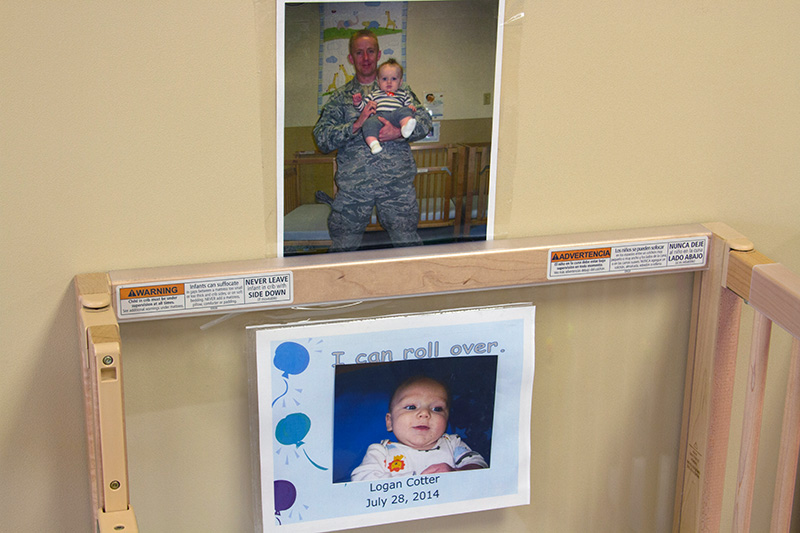
Safe and appropriate materials
Children explore through play, which gives them the opportunity to develop and practice new skills at their own pace. When the environment is free of health and safety hazards, infants and toddlers can explore safely. Caregivers can offer support with materials as infants and toddlers indicate interest and curiosity. Caregivers can:
- Help keep materials clean and safe for infants and toddlers.
- Store adult bags and belongings out of the reach of infants and toddlers.
- Place padding under indoor climbers.
- Store cleaning materials in locked cabinets.
- Create space where toddlers can ride their tricycles and other toys carefully.
- Remove broken toys or play materials.
- Allow infants to explore appropriate materials using all their senses, but remember to clean and sanitize them after they are finished playing.
- Choose toys that can be used in a variety of ways.
- Items that can be taken apart and put back together (boxes, nesting cups, ring stackers)
- Materials that are open-ended and allow for the child to choose how to engage with them (blocks, toys for sand and water play)
- Toys that encourage problem-solving and logical thinking skills
- Offer and use home-like items.
- Items that reflect family experiences (clothing, combs, tools, safe kitchen utensils)
- Different types of paper (coloring paper, paper grocery bags, wrapping paper, newspaper) to manipulate and draw on
- Measuring cups and spoons to use at the sand and water table
- Items that children see adults use (old cell phones, keys, child-size broom and dustpan)
- Provide materials to explore with their senses (seeing, hearing, touching, tasting and smelling).
- Provide duplicates of favorite play items.
- Display toys within reach so that infants and toddlers can see what is available and make choices.
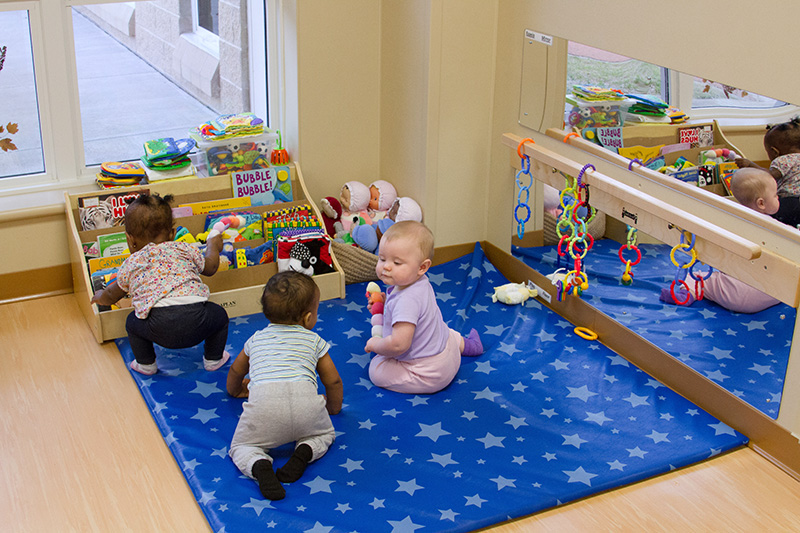
Individualized Care
Each infant and toddler is unique, which requires caregivers to tailor their actions to meet the needs of each child. To achieve individualized care, make sure there are enough adults to safely care for infants and toddlers and to offer primary caregiving and continuity of care. Caregivers can individualize care so that it is responsive to each infant and toddler by engaging in the following processes: observe and document; reflect, interpret and plan; implement; and reflect and evaluate. When caregivers intentionally individualize care for infants and toddlers by using these processes, they have a better understanding of each infant and toddler’s development, how to best support each child’s development, the critical role that relationships play in how infants and toddlers develop, and the importance of the family as a child’s first teacher.
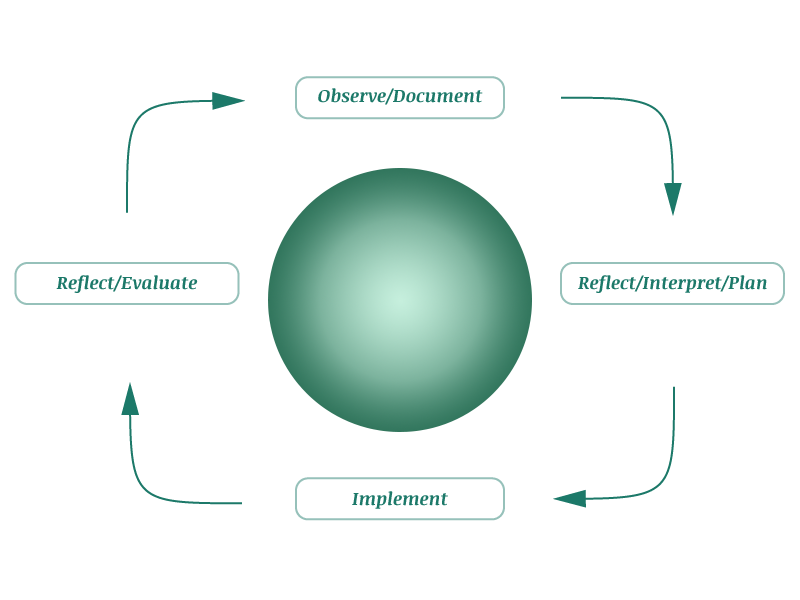
Source: Early Head Start National Resource Center. (2014). Individualized care for infants and toddlers – Part 2. U.S. Department of Health and Human Services, Administration for Children and Families. Washington, DC.
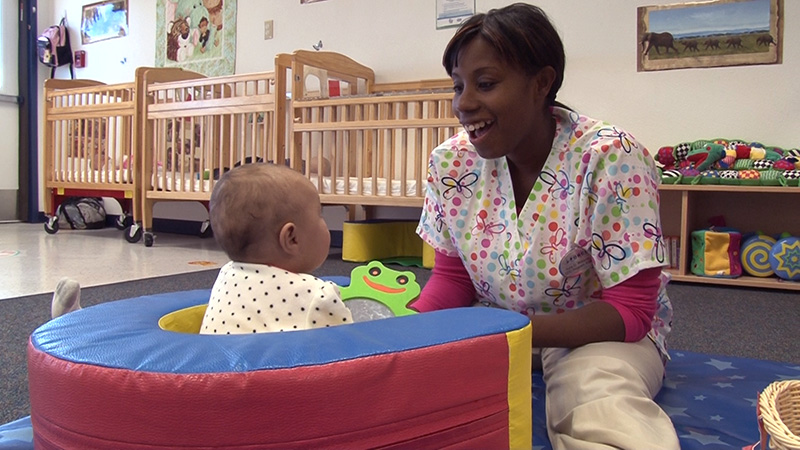
Self-regulation
Self-regulation is impacted by a child’s environment, interactions with others, and temperament. An environment that includes a sufficient number of responsive caregivers is large enough for children to move around freely with secure boundaries and is designed to support engagement in both quiet and active play will help support the development of self-regulation, a core component of social-emotional development.
Early care and learning environments affect social-emotional development in many ways. By surrounding infants and toddlers with responsive, nurturing, and skilled adult caregivers, relationships can be strengthened and the needs of infants and toddlers can be acknowledged and met. When children feel acknowledged and understood, they develop confidence and positive self-esteem. Within the Explore section of this lesson, you will have an opportunity to reflect on and learn more about strategies to continue supporting the social-emotional development of the infants and toddlers in your care.
The Environment's Role in Preventing Challenging Behavior
Think about an infant or toddler who is joining your early care and learning environment for the first time. This may be their first care experience outside of home. Think about what you might observe from an infant or toddler that can offer insight as to what he or she wants and needs in the environment. There are different aspects of the environment that can support a child’s needs. For example:
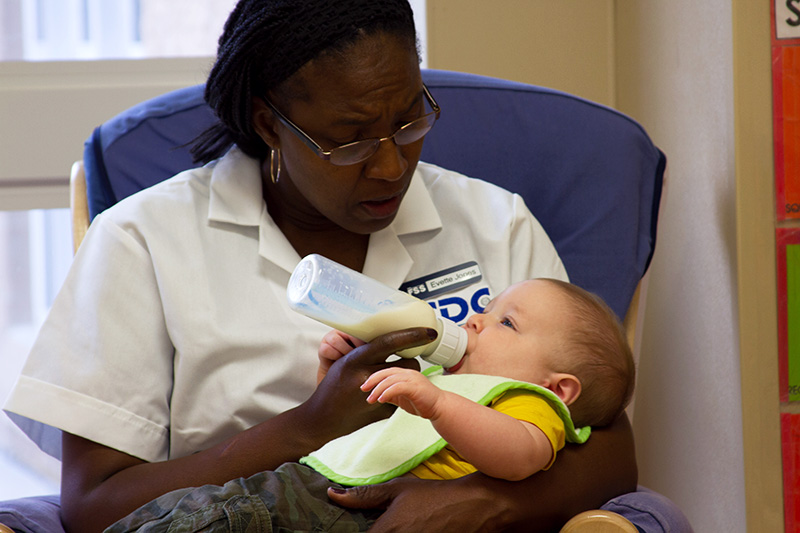
- Responsive, nurturing adults to create feelings of safety
- Areas in which to be close to adults (e.g., gliders and couches to sit comfortably with an adult)
- Spaces to play where things are the right size and safe for exploration
- Spaces to relax and recharge
- Places to crawl, walk, and climb safely
- Soft lighting and natural light from windows
- Neutral-colored walls, furniture, and materials
- Spaces arranged together based on noise-level and lighting needs
- Space to observe, get to know, and play with peers
The environment sends strong messages to infants, toddlers, and families. It provides a story about what you expect, what you will do together, and what you value. A well-planned, safe environment can support engagement, exploration, and focused play. When infants and toddlers are not engaged in play or interested in the materials, they may wander or display challenging behavior.
Each individual brings a unique understanding and preference to the early care and learning setting and may respond differently to the environment. As an infant and toddler caregiver, you should take time to reflect on the environment you have created for infants, toddlers, and families. You might consider additional ways to support social-emotional development that will, in turn, prevent challenging behavior. In the Apply section of this lesson, you will have an opportunity to reflect on and identify ways your environment supports the social-emotional development of infants and toddlers.
Family Engagement In Social-Emotional Development and Learning
Infants and toddlers begin to understand how to build and maintain relationships with others, how to respond to strong emotions, and what social-emotional behaviors are appropriate within a variety of contexts. Families are central to infants’ and toddlers’ abilities to build trusting relationships, self-regulate, and explore. Research highlights that the warmth and skill with which families respond to their child’s needs predicts children’s well-being and positive development in infancy and beyond.
Circumstances may influence and interfere with the family’s ability to support their young child’s social-emotional development. These circumstances, including poverty, loss of employment, deployment, parental depression, domestic violence, and substance abuse, create high levels of stress within a family. This stress can adversely affect care. There is increasing evidence that supporting the social-emotional development of infants and toddlers should be a priority when serving highly stressed infants, toddlers, and their families.
Consider the following strategies to engage families in their children’s social-emotional development:
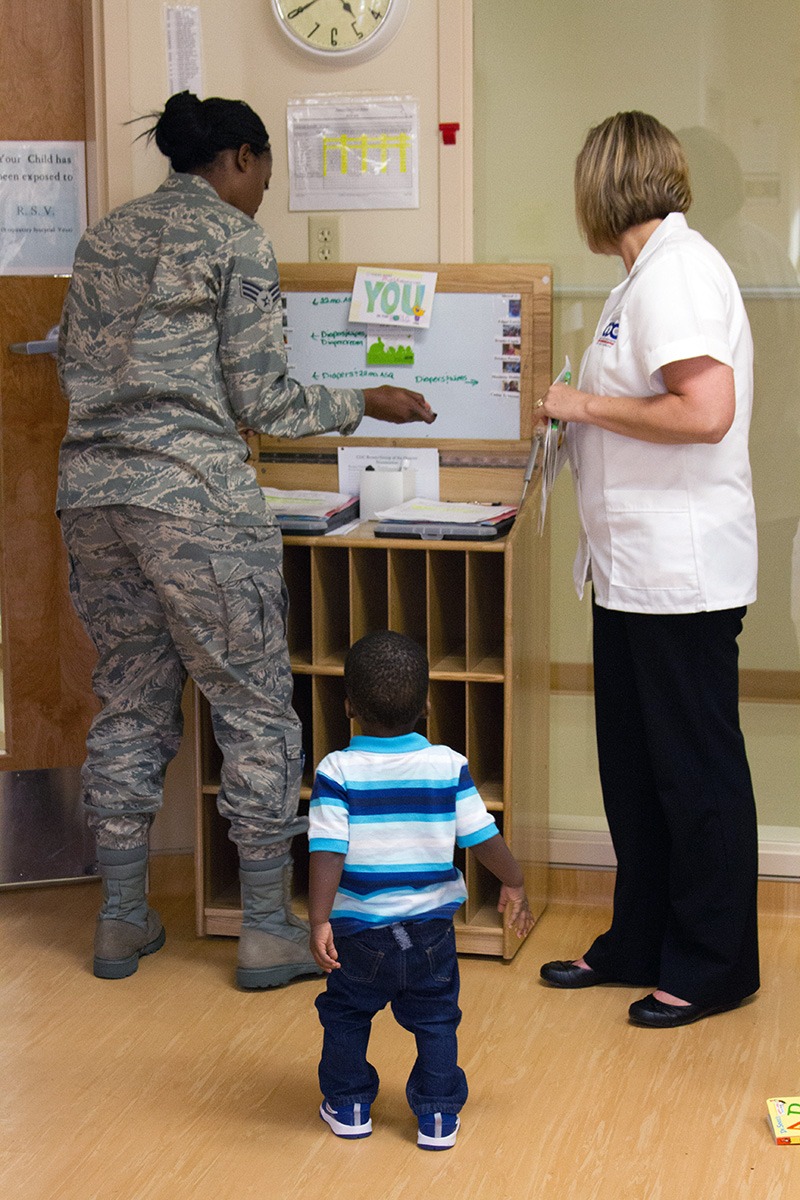
- Ask families to share their thoughts about infant and toddler social-emotional development. Gather information about their backgrounds and beliefs.
- Create books about feelings and friendships for families to read with their children.
- Provide resources about early brain and social-emotional development for families in your resource library.
- Observe how families interact with their child and explain how a particular behavior is typical of the child’s developmental stage to create reasonable expectations for the family: “Toddlers sure are busy and on the go! I bet she keeps you moving.”
- Ask families to share information about their child’s cues such as, what they do when they are hungry or tired.
- Discuss your observations of a particular behavior when families are not pressed for time. Explain the action steps you have taken and ask families to share what they typically do in that situation.
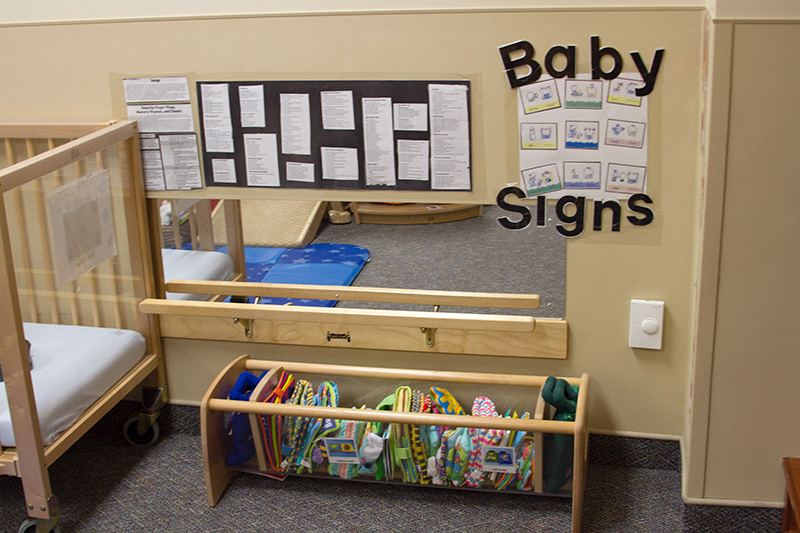
See
Environments that Support Social Emotional Development
Do
The early care and learning environment affects the interactions of infants, toddlers, caregivers, and families. Rather than being in a large group with all of the children in your care, you can offer infants and toddlers cozy spaces so they can have opportunities to rest, observe, take a break from noise and activity, and recharge emotionally. Offering safe, relaxing spaces can help infants and toddlers build a sense of security and feel ready to engage. As an infant and toddler caregiver, you can:
- Provide areas that are soft and inviting, include pillows and soft music.
- Include chairs that can be moved easily.
- Have bins filled with sensory toys (squishy balls, rattles, soft materials) available.
- Use a mattress with a washable cover to create a cozy floor space where infants can rest, observe, roll, or crawl around.
- Use a tube or pop-up tent to offer a space where toddlers can sit, rest, and observe the activities in the room.
Explore
Take time to think more about the routines you have in place for the infants or toddlers in your care. Complete the Responsive Caregiving Routines handout and document the ways you are using these routines to provide opportunities to build relationships and support self-regulation and exploration. Then, share and discuss your responses with a trainer, coach, or administrator.
It is important to offer learning experiences and activities that are appropriate, engaging and supportive of children’s learning and development across various developmental domains including cognitive, social-emotional, physical, language and literacy, and creative development. Staff members working toward their CDA credential should use the CDA Emotional Skills/Regulation Activity Plan handout to develop an emotional skills/regulation learning experience from your curriculum (or a new activity you plan on implementing).
Apply
To think about and better understand the ways your environment supports the social-emotional development of the infants and toddlers in your care, use the Infant Toddler Environment Planning document from the Center on the Social and Emotional Foundations for Early Learning (CSEFEL) and pick one item you would like to learn more about and include in your planning. Then, share and discuss your responses with a trainer, coach, or administrator.
Glossary
Demonstrate
Copple, C, Bredekamp, S. & Koralek, D. (2013). Developmentally appropriate practice: Focus on infants and toddlers. The National Association for the Education of Young Children.
Encyclopedia on Early Childhood Development. (2011, March). Importance of early childhood development. https://www.child-encyclopedia.com/pdf/complet/importance-early-childhood-development
Goleman, D. (2006). Social Intelligence: The new science of human relationships. Bantam Dell.
National Scientific Council on the Developing Child. (2004). Young children develop in an environment of relationships: Working paper no. 1. http://developingchild.harvard.edu/index.php?cID=151
Raikes, H. & Edwards, C. (2010). Extending the dance in infant and toddler caregiving: Enhancing attachment and relationships. (1st ed). Brookes Publishing Company.
Lieberman, A. (2017). The emotional life of the toddler. Simon and Schuster.
Maguire-Fong, M.J. (2020). Teaching and learning with infants and toddlers: Where meaning-making begins. (2nd ed). Teachers College Press.
National Research Council et al. (2012). From Neurons to neighborhoods: An update: Workshop summary. National Academy Press.
Tarullo, L. B. et al. (2015). Measuring the quality of caregiver-child interaction for infants and toddlers. Mathematica Policy Research.
Trevarthen, C., J. Delafield-Butt, & A. Dunlop. (2018). The child’s curriculum: Working with the natural values of young children. Oxford University Press.
Shonkoff, J. P. (2009). Investment in early childhood lays the foundation for a prosperous and sustainable society. http://www.child-encyclopedia.com/pages/PDF/Importance-early-childhood-development.pdf.


